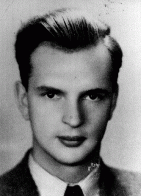You searched for: 外贸公司免费推广【TG飞机:@bapingseo】北京seo外包公司【TG电报:@bapingseo】广州谷歌推广产品【Telegram:@bapingseo】米多多麻将手机版下载安装王者荣耀押注平台亚博网址链接足彩2串1不败公式?0sGj9W/sJ5cTS.html
<< Previous | Displaying results 501-550 of 848 for "外贸公司免费推广【TG飞机:@bapingseo】北京seo外包公司【TG电报:@bapingseo】广州谷歌推广产品【Telegram:@bapingseo】米多多麻将手机版下载安装王者荣耀押注平台亚博网址链接足彩2串1不败公式?0sGj9W/sJ5cTS.html" | Next >>
-
Gisha Galina Bursztyn: Maps
Media EssayBorn to Jewish parents in Poland, Gisha Galina Bursztyn moved to the city of Warsaw after she married. On September 1, 1939, Germany invaded Poland. Warsaw fell four weeks later, and a ghetto was set up in November 1940. During a massive roundup i...
-

-
Chiune Sugihara
Media EssayChiune (Sempo) Sugihara (January 1, 1900-1986) was the first Japanese diplomat posted to Lithu...

-
Lodz ghetto model
ArtifactLeon Jakubowicz, a shoemaker by training and a native of Lodz, began constructing this model of the Lodz ghetto soon after his arrival there from a prisoner-of-war camp in April 1940. The case holds a scale (1:5000) model of the ghetto, including streets, painted houses, bridges, churches, synagogue ruins, factories, cemeteries, and barbed wire around the ghetto edges. The model pieces are made from scrap wood. The case cover interior is lined with a collection of official seals, a ration card, and paper…
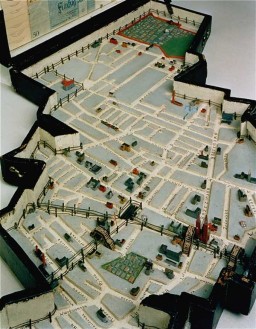
-
Model of the Lodz ghetto
ArtifactLeon Jakubowicz, a shoemaker by training and a native of Lodz, began constructing this model of the Lodz ghetto soon after his arrival there from a prisoner-of-war camp in April 1940. The case holds a scale (1:5000) model of the ghetto, including streets, painted houses, bridges, churches, synagogue ruins, factories, cemeteries, and barbed wire around the ghetto edges. The model pieces are made from scrap wood. The case cover interior is lined with a collection of official seals, a ration card, and paper…
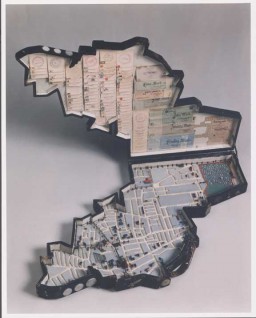
-
Diagram of the “Gypsy camp” in Hodonín u Kunštátu
DocumentDiagram of the Hodonín u Kunštátu (Hodonin bei Kunstadt) camp in the Protectorate of Bohemia and Moravia (Czech Republic). Before it was converted into a Zigeunerlager (“Gypsy camp”) in 1942, it served as a penal labor camp. Translation of key: Scale 1:500 Sleeping quarters Sleeping quarters Mess-hall Infirmary Offices, prison Living quarters for guard staff Economic/Agricultural Building Latrine Well Mess-hall for guard staff Pens for guard dogs
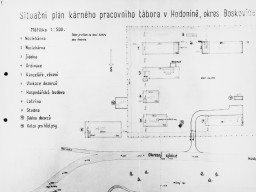
-
Scene during the opening of the 11th Summer Olympic Games
PhotoOn August 1, 1936, Hitler opened the 11th Summer Olympic Games. Inaugurating a new Olympic ritual, a lone runner arrived bearing a torch carried by relay from the site of the ancient Games in Olympia, Greece. This photograph shows an Olympic torch bearer running through Berlin, passing by the Brandenburg Gate, shortly before the opening ceremony. Berlin, Germany, July-August 1936.
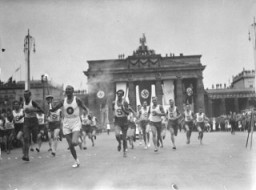
-
SA members post anti-Jewish boycott signs
PhotoAn SA member instructs others where to post anti-Jewish boycott signs on a commercial street in Germany. A German civilian wearing a Nazi armband holds a sheaf of anti-Jewish boycott signs, while SA members paste them on a Jewish-owned business. Most of the signs read, "Germans defend yourselves against Jewish atrocity propaganda/Buy only at German stores." Germany, ca. April 1, 1933.
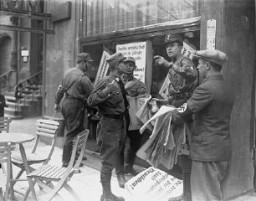
-
The Nazi Olympics Berlin 1936: Inauguration of the Olympic Torch Relay
ArticleThe 1936 Olympics were the first to employ the torch relay. Learn more about this new ritual, Nazi propaganda, and the Olympic Games in Berlin, Germany.

-
Siege (1940)
ArticleJulien Bryan’s ten-minute film Siege, first non-Nazi produced footage of the start of WWII, records horror and chaos in Warsaw following the German invasion.

-
German Administration of Poland
ArticleGermany invaded Poland on September 1, 1939. Learn about the administrative units that Germany established after annexing and occupying parts of prewar Poland.
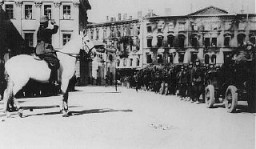
-
Danzig
ArticleHitler was determined to overturn the military and territorial provisions of the Versailles treaty, among it was much resented loss of the city of Danzig after WWI.

-
Encircling the Ruhr
ArticleEncircling the Ruhr region was a key Allied military goal. Learn about the military campaign to capture the industrial center of western Germany in the last months of WWII.
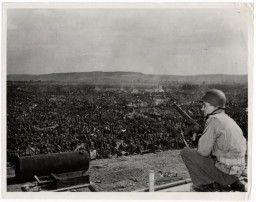
-
Ben Hecht
ArticleAmerican-Jewish journalist and author Ben Hecht co-wrote the We Will Never Die pageant and advocated for the rescue of Jewish victims from Nazism. Learn more.
-
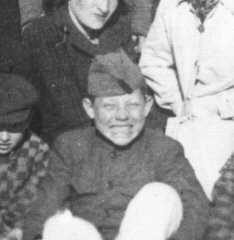
-
Prewar photo of the extended Kracowski family
PhotoThe Kracowski family was living in Bialystok when German Order Police Battalion 309 killed 2,000-3,000 Jews on June 27, 1941. Dr. Samuel Kracowski was among the hundreds of Jews locked in the Great Synagogue and burned alive. After the Germans ordered the establishment of a ghetto in Bialystok, Samuel's wife, Esther, and children, Ewa and Julek, were given a room in the ghetto clinic. Photo dated September 1, 1935. Samuel and Esther are seated in the center, with Julek seated in the front row on the…

-
The 1st Infantry Division during World War II
ArticleThe 1st Infantry Division participated in major WWII campaigns and is recognized for liberating two subcamps of Flossenbürg in 1945.
-
The 99th Infantry Division during World War II
ArticleThe 99th Infantry Division participated in major WWII campaigns and is recognized for liberating subcamps of the Dachau concentration camp in 1945.
-
The Nazi Olympics Berlin 1936
ArticleThe 1936 Olympics in Berlin under Adolf Hitler's Nazi dictatorship were more than just a worldwide sporting event, they were also a show of Nazi propaganda.
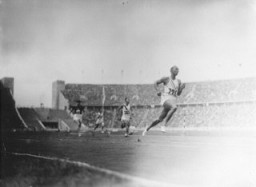
-
Rosa Israel Waldhorn
ID CardRosa was one of 14 children born to religious Jewish parents in the village of Yasinya at a time when it was known as Korosmezo and was part of Hungary. During World War I, she married Michael von Hoppen Waldhorn, an officer in the Austro-Hungarian army who was based near Yasinya. During the 1920s they moved to Paris, where they raised three children. 1933-39: The Waldhorn family's life in Paris was very different from their life in Hungary and Czechoslovakia. Rosa's husband made a good living, and he…
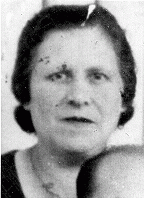
-
Robert Kulka
ID CardRobert was the son of Jewish parents, Leopold and Florentina Kulka, and was raised in the Moravian town of Olomouc. After completing secondary school, he attended a business school until 1909. He began a business in Olomouc and in 1933 he married Elsa Skutezka from the Moravian city of Brno. The couple made their home in Olomouc. 1933-39: The Kulkas' son, Tomas, was born a year and a day after they were married. In 1937 Elsa's father passed away and the Kulkas moved to Brno, where Elsa and her husband…
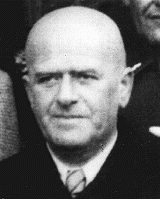
-
Tomas Kulka
ID CardTomas' parents were Jewish. His father, Robert Kulka, was a businessman from the Moravian town of Olomouc. His mother, Elsa Skutezka, was a milliner from Brno, the capital of Moravia. The couple was well-educated and spoke both Czech and German. They married in 1933 and settled in Robert's hometown of Olomouc. 1933-39: Tomas was born a year and a day after his parents were married. When Tomas was 3, his grandfather passed away and the Kulkas moved to Brno, which was his mother's hometown. On March 15,…

-
Ossi Stojka
ID CardOssi was the youngest of six children born to Roma ("Gypsies") who traveled in a family wagon. His family was Roman Catholic. Their caravan spent winters in Vienna, Austria's capital, and summers in the Austrian countryside. The Stojkas belonged to a tribe called the Lowara Roma, who made their living as itinerant horse traders. Ossi's ancestors had lived in Austria for more than 200 years. 1933-39: Ossi was 2 years old when Germany annexed Austria in March 1938. The Stojka family wagon was parked for the…

-
Dismissal letter
DocumentDuring the interwar period Dr. Susanne Engelmann served as the principal of a large public high school for girls in Berlin. This letter notified her of her dismissal, as a "non-Aryan," from her teaching position. The dismissal was in compliance with the Civil Service Law of April 7, 1933. On April 7, the German government issued the Law for the Restoration of the Professional Civil Service (Gesetz zur Wiederherstellung des Berufsbeamtentums), which excluded Jews and political opponents from all civil…
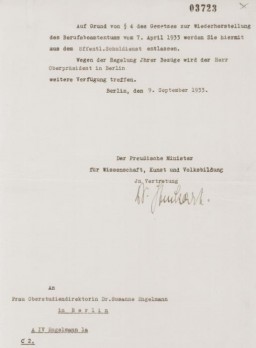
-
German military court trial of French resistance members
FilmFrance signed an armistice with Germany on June 22, 1940, recognizing the right of German authorities to oversee the French administration. Further, German military authorities held jurisdiction over matters of internal security. In this footage, a German military court in Paris tries French citizens charged with resisting measures of the military occupation. Despite harsh military justice, the Germans could not quell opposition in France, and resistance activities would reach a peak during the Allied…

-
German forces in Italy surrender to the Allies
FilmAllied forces occupied most of Germany by the end of April 1945. German forces fighting in Italy were the first to surrender unconditionally to the Allies. Representatives of the German command in Italy signed the surrender on April 29, and it became effective on May 2, 1945. Five days later, on May 7, 1945, Germany surrendered unconditionally to the western Allies, ending the war in Europe.
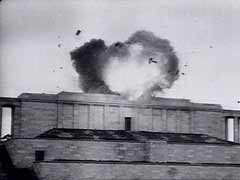
-
Japanese surrender
FilmWorld War II in the Pacific theater ended with the Japanese surrender on September 2, 1945. The surrender was signed in Tokyo Bay aboard the American battleship USS "Missouri." Foreign Minister Shigemitsu headed the Japanese delegation. General Douglas MacArthur accepted the surrender on behalf of the Allies. Admiral Nimitz signed for the US and Admiral Fraser for Britain. Representatives of all the Allied nations attended the signing.

-
US veteran James Rose describes his impressions of Dachau upon liberation
Oral HistoryJames A. Rose, of Toledo, Ohio, was with the 42nd (Rainbow) Division.
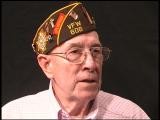
-
The SS
ArticleThe SS (Schutzstaffel) was the elite guard of the Nazi regime and a virtual state within the Third Reich.
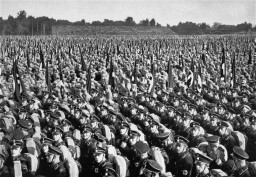
-
Bergen-Belsen: Key Dates
ArticleExplore a timeline of the history of the Bergen-Belsen camp in the Nazi camp system. Initially a POW camp, it became a concentration camp in 1943.
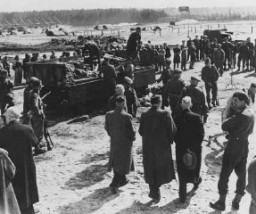
-
Nazi Rule
ArticleAfter they rose to power in 1933, Hitler and the Nazis eliminated democratic freedoms and took control of all aspects of public life in Germany. Learn more.

-
Indoctrinating Youth
ArticleThe Nazi Party targeted German youth as a special audience for its propaganda messages. Read more about the indoctrination of youth.
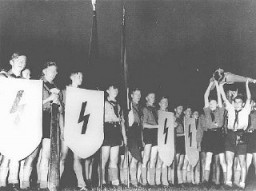
-
Wannsee Conference and the "Final Solution"
ArticleAt the Wannsee conference of January 1942, Nazi Party and German government officials gathered to coordinate implementation of the “Final Solution to the Jewish Question.”

-
Nicholas Winton and the Rescue of Children from Czechoslovakia, 1938–1939
ArticleNicholas Winton organized a rescue operation that brought hundreds of children, mostly Jewish, from Czechoslovakia to safety in Great Britain before the outbreak of WWII.

-
German Military Oaths
ArticleIn Nazi Germany, German military personnel swore an oath directly to Adolf Hitler. Learn about the oath and its impact.
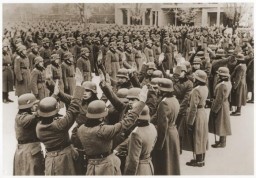
-
The Rwanda Genocide
ArticleFrom April to July 1994, extremist leaders of Rwanda’s Hutu majority directed a genocide against the country’s Tutsi minority. Learn more

-
First Kindertransport Arrives in Great Britain
Timeline EventDecember 2, 1938. On this date, the first Kindertransport of German Jewish children arrived in Great Britain.
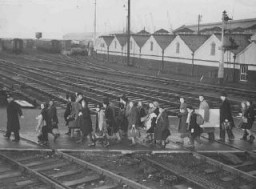
-
Transnistria Governorate
ArticleThe Transnistria Governorate was established in occupied Soviet Ukraine during WWII. Learn more about the Holocaust in Transnistria between 1941-1944.
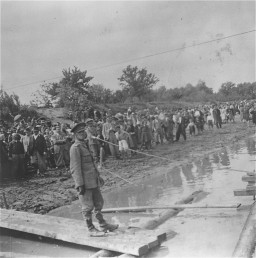
-
Leo Diamantstein describes Nazi marches and the Hitler Youth
Oral HistoryJoseph Leo Diamantstein was born in Heidelberg, Germany, on December 1, 1924, to Jewish parents. He was the youngest of four children. His family experienced antisemitism in Frankfurt, and ultimately decided to leave Germany. Beginning in 1933, the Hitler Youth and the League of German Girls had an important role to play in the new Nazi regime. Through these organizations, the Nazi regime planned to indoctrinate young people with Nazi ideology. This was part of the process of Nazifying German…
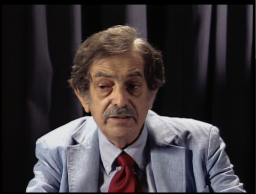
-
Trawniki
ArticleFrom July 1941-May 1944, the SS camp at Trawniki had several purposes. It is best known as the training site for auxiliary police guards used in Nazi killing centers. Learn more.

-
Heinrich Himmler
ArticleSS Chief Heinrich Himmler was chief architect of the "Final Solution." Learn more about Himmler, one of the most powerful men after Hitler in Nazi Germany.

-
Auschwitz
ArticleThe Auschwitz camp system, located in German-occupied Poland, was a complex of 3 camps, including a killing center. Learn about the history of Auschwitz.
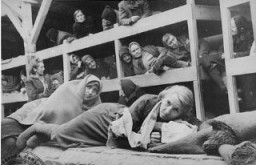
-
Lesbians under the Nazi Regime
ArticleBeginning in 1933, the Nazi regime harassed and destroyed lesbian communities and networks that had developed during the Weimar Republic.
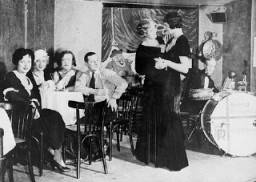
-
Hodonín U Kunštátu (Hodonín bei Kunstadt) (Roma camp)
ArticleIn March 1942, the Hodonin camp was classified as a camp for Roma. It was a transfer station during deportation to Auschwitz-Birkenau. Learn about the camp and its history.

-
The United States: Isolation-Intervention
ArticleWhen WWII began, most Americans wanted the US to stay isolated from the war. From December 1941, the majority rallied in support of intervention to defeat the Axis powers.

-
Stanisławów
ArticleLearn more about the history of Stanisławów during the Holocaust and World War II.
-
The Holocaust in Odesa
ArticleIn October 1941, Romania, an ally of Nazi Germany, perpetrated mass killings of Jews in Odesa. Learn more about the Holocaust in Odesa and Ukraine.

-
Szlamach Radoszynski
ID CardSzlamach was one of six children born to Yiddish-speaking, religious Jewish parents. Szlamach's father was a peddler, and the Radoszynski family lived in a modest apartment in Warsaw's Praga section on the east bank of the Vistula River. After completing his schooling at the age of 16, Szlamach apprenticed to become a furrier. 1933-39: During the 1930s Szlamach owned a fur business. Despite the Depression, he was hoping the economy would turn around so that he could make enough money to move into his own…

-
Odon Jerzy Wos
ID CardOdon was the third of four children born to Roman Catholic parents in Warsaw, Poland's capital. His father had worked for the Polish merchant marine before starting his own textile business in 1930. When Odon was 8, the family moved to a comfortable apartment located near the Royal Castle and Vistula River. In 1932 Odon began attending grade school. 1933-39: In September 1938 Odon began secondary school. Sensing growing danger from Germany, his father advised him to study German in addition to French. On…

-
Mieczyslaw (Marek) Madejski
ID CardMieczyslaw was the eldest of three sons born to well-to-do Roman Catholic parents in Poland's capital of Warsaw. His father was a real estate developer and his mother was a housewife. Mieczyslaw, or Mieteck as he was nicknamed, began attending public elementary school in 1930 when he was 7 years old. 1933-39: Mieczyslaw's father urged him to study either German or Russian because he thought it was likely that there would be a German or Soviet invasion. Germany invaded Poland on September 1, 1939. During…
